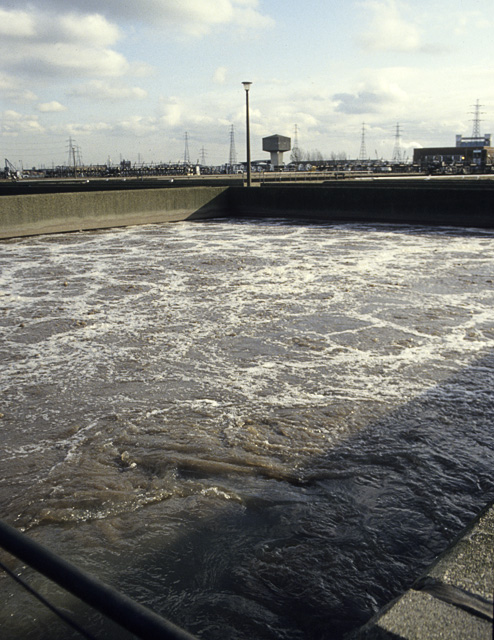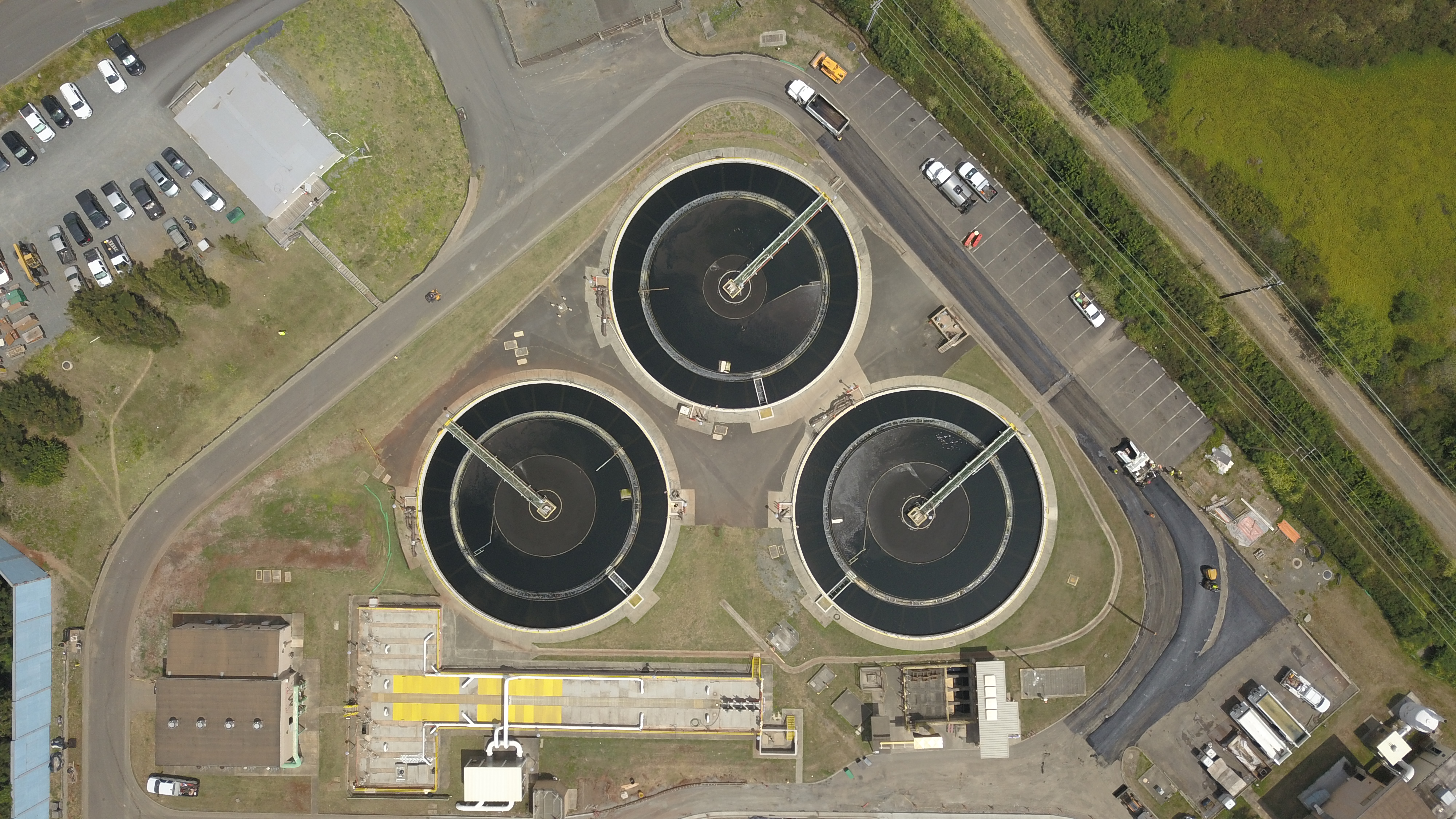|
Extended Aeration
Extended aeration is a method of sewage treatment using modified activated sludge procedures. It is preferred for relatively small waste loads, where lower operating efficiency is offset by mechanical simplicity.Steel & McGhee (1979) p.501 Conventional sewage treatment Mechanized sewage treatment typically includes settling in a primary clarifier, followed by biological treatment and a secondary clarifier. Both clarifiers produce waste sludge requiring sewage sludge treatment and disposal. Activated sludge agitates a portion of the secondary clarifier sludge in the primary clarifier effluent. Remaining secondary sludge and all primary sludge typically require digestion prior to disposal. Process modification Extended aeration agitates all incoming waste in the sludge from a single clarifier. The combined sludge starts with a higher concentration of inert solids than typical secondary sludge and the longer mixing time required for digestion of primary solids in addition to disso ... [...More Info...] [...Related Items...] OR: [Wikipedia] [Google] [Baidu] |
Activated Sludge
The activated sludge process is a type of biological wastewater treatment process for treating sewage or industrial wastewaters using aeration and a biological floc composed of bacteria and protozoa. It uses air (or oxygen) and microorganisms to biologically oxidize organic pollutants, producing a waste sludge (or floc) containing the oxidized material. The activated sludge process for removing carbonaceous pollution begins with an aeration tank where air (or oxygen) is injected into the waste water. This is followed by a settling tank to allow the biological flocs (the sludge blanket) to settle, thus separating the biological sludge from the clear treated water. Part of the waste sludge is recycled to the aeration tank and the remaining waste sludge is removed for further treatment and ultimate disposal. Plant types include package plants, oxidation ditch, deep shaft/vertical treatment, surface-aerated basins, sequencing batch reactors (SBRs). Aeration methods include diff ... [...More Info...] [...Related Items...] OR: [Wikipedia] [Google] [Baidu] |
Sewage Treatment
Sewage treatment (or domestic wastewater treatment, municipal wastewater treatment) is a type of wastewater treatment which aims to remove contaminants from sewage to produce an effluent that is suitable for discharge to the surrounding environment or an intended reuse application, thereby preventing water pollution from raw sewage discharges. Sewage contains wastewater from households and businesses and possibly pre-treated industrial wastewater. There are a high number of sewage treatment processes to choose from. These can range from decentralized systems (including on-site treatment systems) to large centralized systems involving a network of pipes and pump stations (called sewerage) which convey the sewage to a treatment plant. For cities that have a combined sewer, the sewers will also carry urban runoff (stormwater) to the sewage treatment plant. Sewage treatment often involves two main stages, called primary and secondary treatment, while advanced treatment also incor ... [...More Info...] [...Related Items...] OR: [Wikipedia] [Google] [Baidu] |
Clarifier
Clarifiers are settling tanks built with mechanical means for continuous removal of solids being deposited by sedimentation. A clarifier is generally used to remove solid particulates or suspended solids from liquid for clarification and/or thickening. Inside the clarifier, solid contaminants will settle down to the bottom of the tank where it is collected by a scraper mechanism. Concentrated impurities, discharged from the bottom of the tank, are known as sludge, while the particles that float to the surface of the liquid are called scum. Applications Pretreatment Before the water enters the clarifier, coagulation and flocculation reagents, such as polyelectrolytes and ferric sulfate,Brentwood Industries, Inc. (2013)"Tube Settler Systems For Clarification." Accessed 14 October 2013. can be added. These reagents cause finely suspended particles to clump together and form larger and denser particles, called flocs, that settle more quickly and stably. This allows the separation of ... [...More Info...] [...Related Items...] OR: [Wikipedia] [Google] [Baidu] |
Sludge
Sludge is a semi-solid slurry that can be produced from a range of industrial processes, from water treatment, wastewater treatment or on-site sanitation systems. For example, it can be produced as a settled suspension obtained from conventional drinking water treatment, as sewage sludge from wastewater treatment processes or as fecal sludge from pit latrines and septic tanks. The term is also sometimes used as a generic term for solids separated from suspension in a liquid; this 'soupy' material usually contains significant quantities of 'interstitial' water (between the solid particles). Sludge can consist of a variety of particles, such as animal manure. Industrial wastewater treatment plants produce solids that are also referred to as sludge. This can be generated from biological or physical-chemical processes. In the activated sludge process for wastewater treatment, the terms "waste activated sludge" and "return activated sludge" are used. In food processing and bevera ... [...More Info...] [...Related Items...] OR: [Wikipedia] [Google] [Baidu] |
Sewage Sludge Treatment
Sewage sludge treatment describes the processes used to manage and dispose of sewage sludge produced during sewage treatment. Sludge treatment is focused on reducing sludge weight and volume to reduce transportation and disposal costs, and on reducing potential health risks of disposal options. Water removal is the primary means of weight and volume reduction, while pathogen destruction is frequently accomplished through heating during thermophilic digestion, composting, or incineration. The choice of a sludge treatment method depends on the volume of sludge generated, and comparison of treatment costs required for available disposal options. Air-drying and composting may be attractive to rural communities, while limited land availability may make aerobic digestion and mechanical dewatering preferable for cities, and economies of scale may encourage energy recovery alternatives in metropolitan areas. Sludge is mostly water with some amounts of solid material removed from liquid sew ... [...More Info...] [...Related Items...] OR: [Wikipedia] [Google] [Baidu] |


